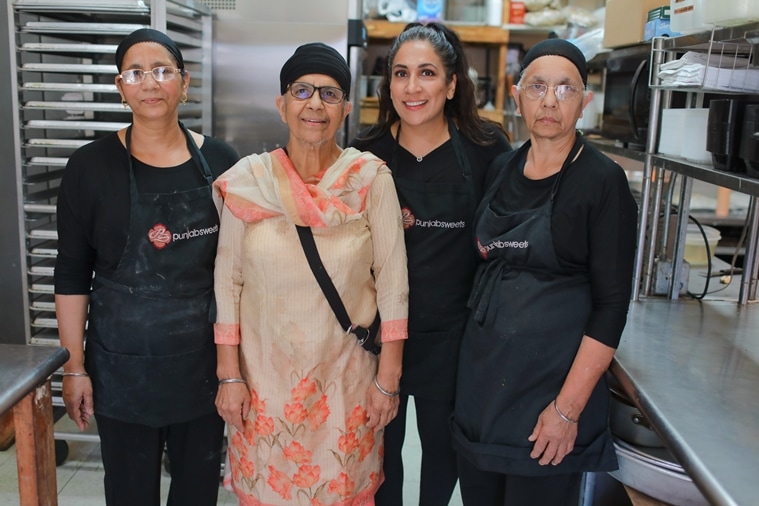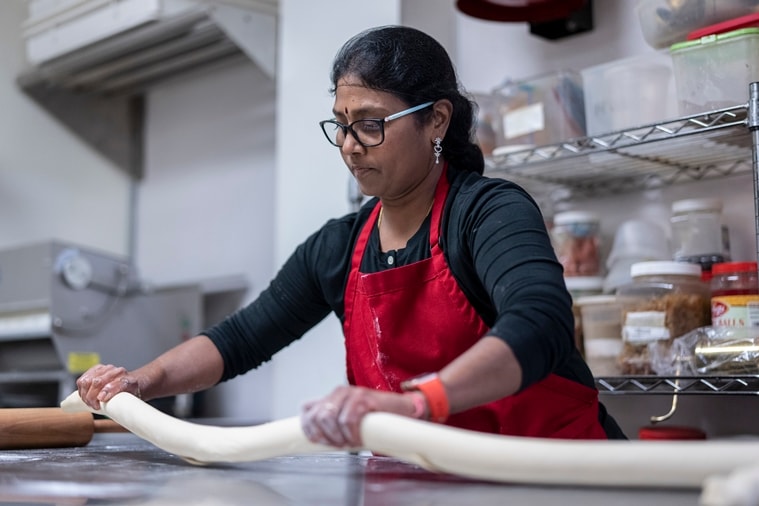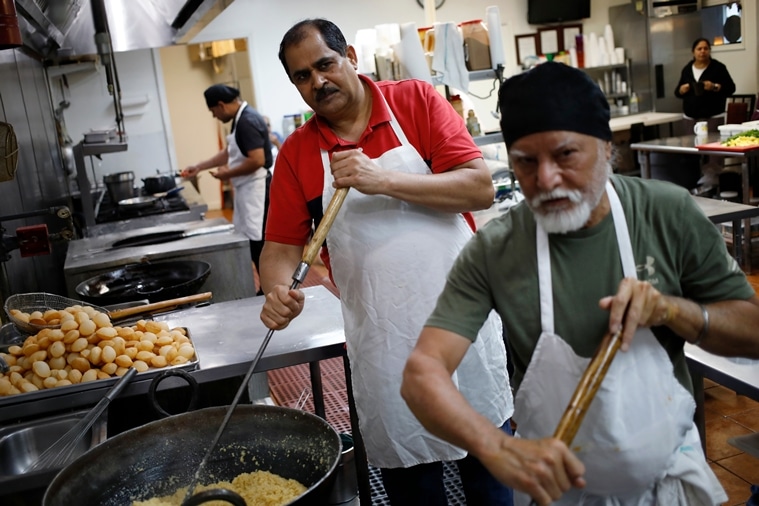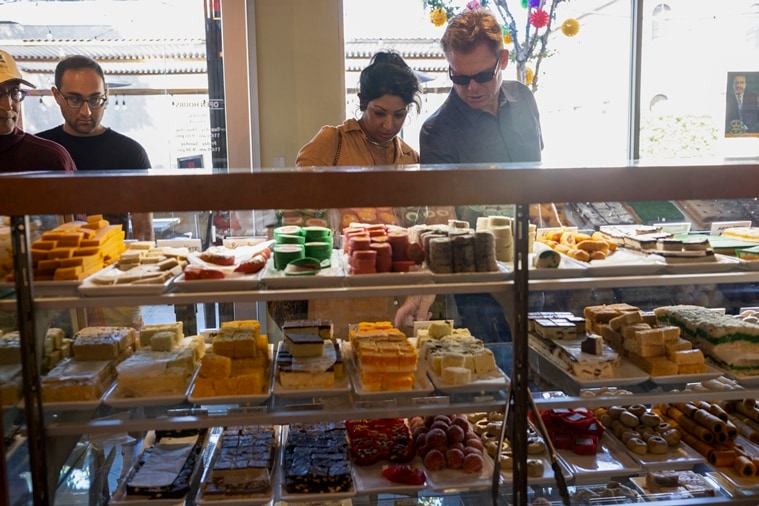[ad_1]
Visiting a South Asian sweet shop during Diwali is a joyous and chaotic experience. Lines trail out the door. Employees furiously pack ornate boxes containing laddoos enriched with ghee, spongy rasgula and all manner of colorful sweets, often made with dairy, sugar and nuts and sometimes topped with a layer of edible silver foil. Friends and relatives meet around the display cases by happenstance, exchanging good wishes. Diwali, which will be celebrated within South Asia and among its diaspora on Oct. 24 this year, commemorates the triumph of light over darkness. Central to that celebration is mithai, or sweets. Mass-produced mithai are readily available online, but these five independent shops make their sweets by hand every day, offering their local South Asian communities a taste of the familiar. Diwali is their prime time.
Maharaja Sweets, Jackson Heights, Queens
When Sukhdev Bawa immigrated to New York in 1981, his first job was driving a taxi. “My wife thought it was too dangerous,” he said. So he switched over to the sweets business, working for two other shops before starting his own. At Maharaja Sweets, which he opened on a busy stretch of Jackson Heights, Queens, in 2000, he prepares snacks like mathi, deep-fried dough rounds that can be sweet or savory.
Bawa’s employees travel to India frequently to bring back ideas for regional sweets to add to the menu, like anarkali, a Bengali sweet filled with cherry and pistachio, and rose bahar, squares filled with rose-flavored sugar.
 Sukhdev Bawa prepares desserts at his shop Maharaja Sweets, one of New York City’s most beloved South Asian sweet shops. (Gabriela Bhaskar/The New York Times)
Sukhdev Bawa prepares desserts at his shop Maharaja Sweets, one of New York City’s most beloved South Asian sweet shops. (Gabriela Bhaskar/The New York Times)
Maharaja sells about 80 different kinds of sweets. And while some shops use shortcuts, like milk powder, to produce such large quantities of mithai, Bawa prefers to use fresh milk: “We get the proper taste.”
Bawa estimates that Diwali business accounts for 20% of his annual sales. He also ships his sweets across the country, and recently opened a factory nearby that has allowed him to expand production.
Maharaja Sweets, 73-10 37th Ave., Queens, New York, 718-505-2680, maharajasweetsny.us
Punjab Sweets, Kent, Washington
Before she opened Punjab Sweets in Kent, Washington, in 2001, Iqbal Dha, the owner, said she used to drive more than three hours to Canada to buy mithai like besan burfi, which is made with chickpea flour, and milk cake, which is prepared by cooking milk down to a thicker consistency and mixing it with sugar.
Dha, wearing a colorful salwar kameez alongside her employees, learned to cook from her mother, and from preparing meals for langar, a Sikh tradition that provides free communal meals to anyone who needs one. She’s particular about what she eats, she said. “If I go to any wedding parties, I never eat because I don’t like it,” she said. “I like my food. I always eat at Punjabi Sweets. My employees, too.”
 From left: Nirmala; Iqbal Dha (the owner); Harpreet Kaur; and Manjit Kaur in the all-female kitchen at Punjab Sweets in Kent. (Genna Martin/The New York Times)
From left: Nirmala; Iqbal Dha (the owner); Harpreet Kaur; and Manjit Kaur in the all-female kitchen at Punjab Sweets in Kent. (Genna Martin/The New York Times)
Her kitchen staff is made up entirely of women. “Men only clean up.”
She shut down indoor dining during the pandemic, but hopes to have it back up and running soon. Like many mithai shops, Punjab Sweets is a watering hole for the local Desi community. “People are calling me at home, saying, ‘We miss Punjabi Sweets,’” Dha said.
“People have been buying from here since they were kids,” she said. Customers call her auntie, nani, dadi and grandma. “They go to college, get married, they still come to buy sweets and make me happy.”
Punjab Sweets, 23617 104th Ave. SE C, Kent, Washington, 253-859-3236, punjabsweetsonline.com
Jayasri Sweets, Herndon, Virginia
Jayasri Sweets in Herndon, Virginia, is known for its kaja, a flaky, deep-fried pastry from Andhra Pradesh. It is a specialty of the owner, Jayasri Gampa, who shapes the dough every day the shop is open. You won’t find the regional confection at many other mithai shops in the United States. Her version is glazed on the outside and crunchy with sugar on the inside.
 Jayasri Gampa, owner and chef at Jayasri Sweets in Herdon. (Sanjay Suchak/The New York Times)
Jayasri Gampa, owner and chef at Jayasri Sweets in Herdon. (Sanjay Suchak/The New York Times)
The kaja has developed a reputation outside of the Washington, D.C., suburb. “People even started taking it back home to India to show them how the American kaja is,” said Gampa’s husband, Dilipkumar, who helps run the business. “It has become that popular.”
Jayasri Sweets, 313 Sunset Park Drive, Herndon, Virginia, 703-787-9649, jayasrisweets.com
Brij Mohan Indian Sweets and Restaurant, Sharonville, Ohio
Preparations for Diwali begin at least a month ahead of the holiday at Brij Mohan Indian Sweets and Restaurant, about 18 miles outside Cincinnati. The Gaba family started working in the sweets business in Punjab, where they ran a shop in the late 1970s.
The family opened Brij Mohan in 2005. Sohan Lal Gaba, an owner, said that when he moved to the United States, the quality of milk, sugar and chickpea flour was much different than what he was used to in India. “There was no one to teach me about the ingredients and everything here,” he said. “I just figured it out myself, what I can do with available ingredients.”
 Parmjeet Gaba, center, one of the owners of Brij Mohan Indian Sweets and Restaurant in Sharonville, Ohio. (Luke Sharrett/The New York Times)
Parmjeet Gaba, center, one of the owners of Brij Mohan Indian Sweets and Restaurant in Sharonville, Ohio. (Luke Sharrett/The New York Times)
He has grown accustomed to using cow’s milk instead of buffalo milk, for example, in sweets like the shop’s bestselling slabs of milk cake, and sandwich gulab jamun filled with sweetened milk solids.
As people become increasingly comfortable hosting celebrations, “Diwali this year will be even busier than last year,” said Saakhi Grover, an assistant manager and a daughter-in-law of Gaba. Cooks will work long hours preparing sweets and snacks like pani puri. “We start from the morning, and it goes until the night. We don’t close for three days.”
Brij Mohan Indian Sweets and Restaurant, 11259 Reading Road, Sharonville, Ohio, 513-769-4549, brijmohancincinnati.com
Surati Farsan Mart, Artesia, California
Surati Farsan Mart has continually expanded its offerings — which include cashew-based kaju katli and coconut-rich kopra pak — to meet the demand of the growing population of South Asian Americans in Artesia, California. During Diwali, staff deck out the shop with lights and decorations.
“We have probably 20 hour days for about two weeks,” said Ashvin Patel, the owner. He hires security to do crowd control. “It is crazy. The adrenaline kicks in.”
Patel’s parents, Ramila and Nathu, started the shop in 1986 after immigrating from Leicester, England. Mr. Patel now runs the place, and has focused on modernizing the store’s design and expanding its online presence.
 People shop at Surati Farsan Mart in Artesia, California. (Elizabeth Lippman/The New York Times)
People shop at Surati Farsan Mart in Artesia, California. (Elizabeth Lippman/The New York Times)
While traditional sweets like kaju katli are the top sellers at the shop, Patel also offers more contemporary varieties — like green- and pink-hued watermelon burfi made with pistachios, cashews and raisins shaped to look like the fruit — to keep up with the innovation that is already happening in India. “They are probably even more advanced than we are when it comes to fusion ideas,” he said.
When it comes to mithai, freshness is everything, Patel said. Surati’s confections — like sweet, fudgy rolls flavored with almonds and pistachios — are made every two days, and hot, syrup-soaked jalebi are made every day. Patrons ask him about opening other locations, but Patel doesn’t want to. “You stretch yourself thin, and the quality and the service would suffer.”
Surati Farsan Mart, 11814 E. 186th St., Artesia, California, 562-860-2310, suratifarsan.com.
—
RECIPES:
Coconut Laddoo
These round treats are a coconut lover’s dream — and best of all, they’re just three ingredients. Coconut laddoo is a type of mithai, or sweet, typically found in South Asian shops and served for celebratory occasions. While many types of mithai are milk- or nut-based, this one lets the coconut do all the talking, and a little bit of cardamom provides a floral edge. This particular variety is a crowd favorite at Jayasri Sweets in Herndon, Virginia, and the recipe comes from the shop’s owner, Jayasri Gampa. This recipe works best with fresh coconut (frozen is fine); dried coconut doesn’t have enough moisture for the mixture to hold together.
By Priya Krishna and Cathy Lo
Yield: About 16 laddoos
Total time: 30 minutes
Ingredients:
4 cups/480 grams lightly packed unsweetened grated frozen (thawed) coconut, or grated fresh coconut
4 cups/804 grams sugar
1/4 teaspoon ground cardamom (optional)
Preparation:
1. Combine the coconut and sugar in a large, heavy-bottomed pot or Dutch oven and mix well. Cook on medium-low heat, stirring frequently and scraping the side and bottom of the pot, until the sugar has melted and starts to bubble, about 15 minutes.
2. Remove from the heat and stir in the cardamom, if using, until incorporated. Let cool slightly, undisturbed, until the mixture forms a very slight crust on the surface but is still moist and sticky underneath, 20 minutes.
3. Using your hands, form the mixture into 2-inch balls (you can make smaller balls if you prefer). Let cool until the laddoos are firm, 10 to 15 minutes. Serve the coconut laddoos immediately or store in an airtight container for up to 3 days. Caramel Badam Burfi
Badam burfi, a rich, fudgy treat made of almonds, milk and sugar, is a classic Indian sweet. This version, developed by Ashvin Patel, who runs Surati Farsan Mart in Artesia, California, incorporates caramel for an even more decadent sweet that tastes somewhere between mithai and a candy bar. These treats are eaten throughout the South Asian subcontinent for celebrations both big and small, from Diwali to a good score on a test. They travel well and can be frozen for at least a few weeks. If the almond base seems a bit dry, kneading it with your hands will help incorporate the milk mixture more completely.
By Priya Krishna and Jesse Szewczyk
Yield: 35 (1 1/2-inch) pieces
Total time: 20 minutes, plus cooling
Ingredients:
Nonstick cooking spray
2 cups/16 ounces whole milk
1 cup/200 grams sugar
1/4 ounce yellow liquid food coloring (optional)
6 cups/671 grams finely ground almond flour (from blanched almonds)
11 ounces/311 grams soft caramel candies (such as Kraft brand), about 1 3/4 cups, unwrapped
10 ounces/283 grams whole raw almonds (about 2 cups)
Preparation:
1. Grease a 9-by-13-inch metal or glass baking pan with nonstick cooking spray and line with a strip of parchment paper that hangs over the two long sides to create a sling.
2. In a large pot or Dutch oven over medium heat, combine the milk and sugar, and bring to a boil, stirring occasionally, 5 to 6 minutes.
3. Remove from the heat and stir in the food coloring, if using, then gradually stir in the almond flour until a thick, doughlike paste forms with no pockets of unincorporated almond flour. If the mixture is too thick to stir, use your hands to knead it together. (Be careful, the mixture will still be slightly hot. Let cool for 2 to 3 minutes if necessary.)
4. Transfer the mixture to the prepared pan and press it into an even layer using your hands.
5. Place the caramels and 2 tablespoons of water in a small saucepan. Cook over low heat, stirring often, until the caramels are completely melted, 6 to 8 minutes. Pour the caramel over the top of the almond base and use a heatproof spatula to spread it into an even layer.
6. Evenly sprinkle the whole almonds over the warm caramel and press them in using the back of a spatula to help them adhere. Let cool until the caramel is set and firm to the touch, about 2 hours. Cut into small squares using a serrated knife to serve.
This article originally appeared in The New York Times.
📣 For more lifestyle news, follow us on Instagram | Twitter | Facebook and don’t miss out on the latest updates!
[ad_2]
Source link


